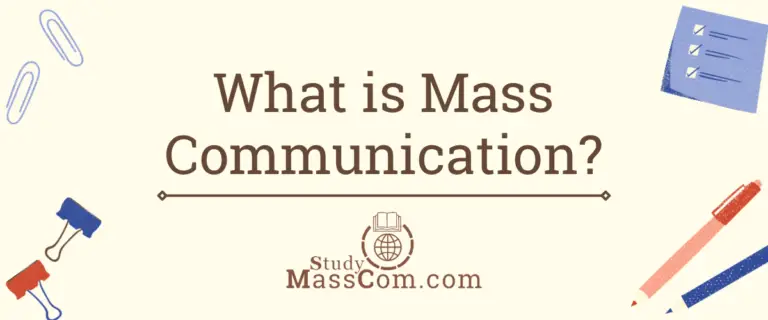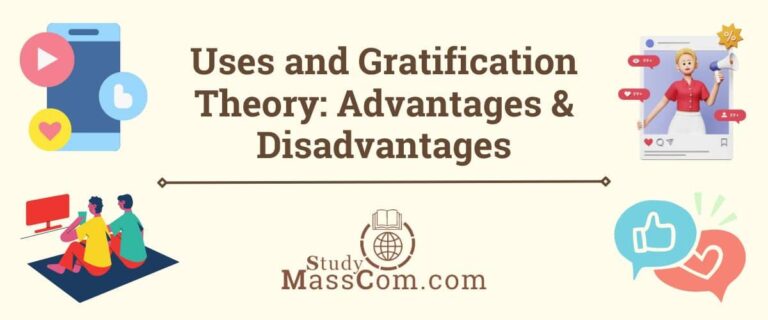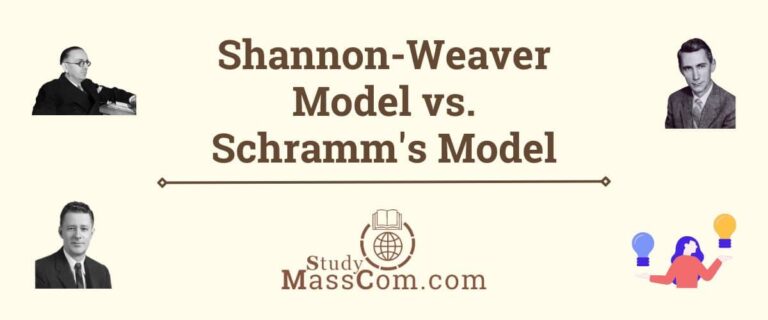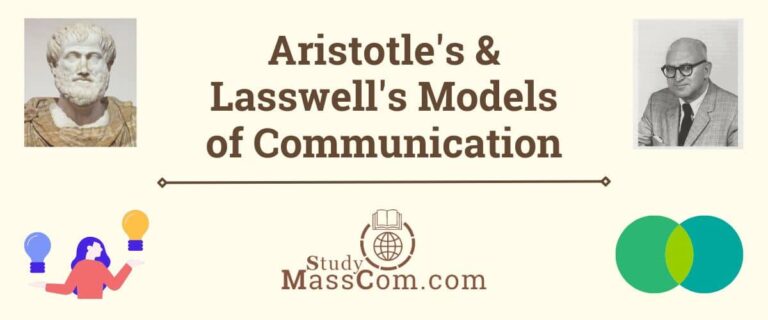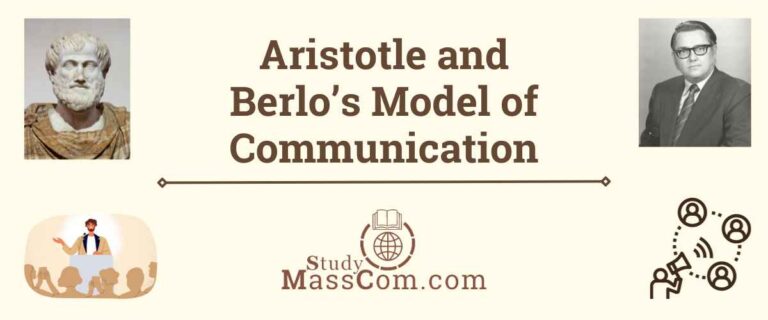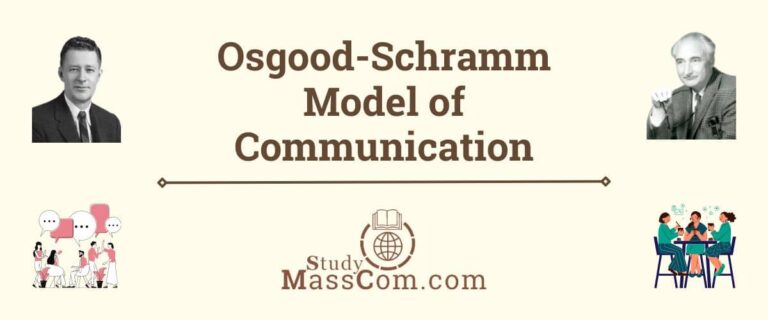Aristotle Model of Communication: Advantages and Disadvantages
Aristotle contributed significantly to the field of rhetoric and communication through his work on persuasive communication and effective argumentation. Aristotle did not provide a single, comprehensive definition of communication in the way that modern communication scholars might. However, his works, particularly those related to rhetoric, contain insights into how he understood the process of communication. In Aristotle’s view, communication is primarily concerned with persuasive discourse and the art of effective persuasion. He emphasized the role of rhetoric in communication, which involves using language and argumentation to influence an audience’s beliefs, attitudes, and actions.

Definition of Aristotle Model of Communication
Aristotle’s communication theories, often discussed in his work “Rhetoric” (4th century BCE), revolve around the art of persuasion and the means by which people can influence others through speech and discourse. He outlined three main components of persuasive communication that include:
- Rhetoric
- Ethos, Pathos, and Logos
- Persuasion and Audience Analysis
Rhetoric
Aristotle defined rhetoric as the faculty of discovering the available means of persuasion in a given situation. It involves crafting persuasive messages and arguments that are tailored to the audience’s characteristics and emotions. Rhetoric is not just about conveying information, but also about convincing and persuading others. Alongside that, ethos, pathos, and logos are the three persuasive appeals that Aristotle identified as essential components of effective communication.
Ethos
This refers to the speaker’s credibility and character. A persuasive message is more effective when it comes from someone who is perceived as trustworthy, knowledgeable, and morally upright.
Pathos
Pathos appeals to the audience’s emotions. Aristotle believed that emotions play a crucial role in persuasion, and a communicator can effectively sway an audience by evoking specific emotional responses through their speech.
Logos
Logos refers to the logical appeal of an argument. Communicators should present a well-structured and reasoned argument, using evidence and reasoning to support their claims.
Persuasion and Audience Analysis
Aristotle emphasized the importance of understanding the audience’s beliefs, values, and emotions. Effective communication requires adapting the message to the specific characteristics of the audience.
While Aristotle’s focus was more on the art of persuasion and rhetoric, his ideas have had a lasting impact on communication theory and practice. His insights into understanding the audience, using emotions, and crafting compelling arguments continue to influence how we think about communication strategies and persuasive discourse.
Elements of Aristotle Model of Communication
Aristotle’s communication model, although not explicitly presented in a modern diagrammatic form, can be understood through his concepts related to persuasive communication and rhetoric. Here are five key elements that represent Aristotle’s communication model:
Speaker (Rhetor)
The communicator or speaker is a central figure in Aristotle’s communication model. The speaker is responsible for crafting and delivering persuasive messages to the audience. The speaker’s credibility (ethos), ability to evoke emotions (pathos), and use of logical arguments (logos) play essential roles in influencing the audience.
Message (Logos)
The message is the content of communication. Aristotle emphasized the importance of constructing a well-structured and logically sound argument. This involves presenting evidence, reasoning, and examples to support the speaker’s claims and persuade the audience of a particular viewpoint.
Audience (Listener/Viewer)
The audience is a crucial component of the communication process. Aristotle emphasized the significance of analyzing the audience’s characteristics, beliefs, emotions, and values. Effective communication requires tailoring the message to resonate with the audience’s interests and persuading them based on their specific context.
Occasion
In Aristotle’s model of communication, the “occasion” refers to the specific context or situation in which communication takes place. While the concept of occasion is not always explicitly discussed in his works, it is an important element that underlies his ideas about persuasive communication and rhetoric. Aristotle believed that effective communication requires a deep understanding of the occasion, including factors such as the audience, the purpose of communication, the cultural and social context, and the timing of the message. The occasion influences how the speaker tailors their message to connect with the audience and achieve the desired persuasive outcome.
Effect
In Aristotle’s model of communication, the concept of “effect” refers to the intended impact or outcome of persuasive communication. It is one of the fundamental elements that the speaker aims to achieve through effective rhetoric and persuasive discourse. Aristotle’s focus on effect underscores the goal-oriented nature of communication, where the speaker seeks to influence the audience’s beliefs, attitudes, and actions.
These five elements—speaker, message, audience, occasion, and effect—form the core components of Aristotle Model of Communication, which revolves around the art of persuasion and effective discourse.
Explore the seven essential steps in the communication process.
Diagram of Aristotle Model of Communication
Aristotle’s model of communication is not typically represented in a diagrammatic form like modern communication models. However, here is a simplified diagram that captures the key elements and relationships in Aristotle’s model:

Please note that this diagram simplifies the model for visualization purposes. In reality, the interactions between the elements are more complex and dynamic. The model emphasizes the interplay between the speaker’s use of ethos, pathos, and logos to craft a message tailored to the audience and occasion, with the ultimate goal of achieving a desired persuasive effect.
Advantages of Aristotle Model of Communication
Aristotle’s model of communication, rooted in the principles of rhetoric and persuasive discourse, offers several advantages that continue to be relevant and applicable in various communication contexts. Some of the advantages of Aristotle’s model include:
Emphasis on Persuasion
Aristotle’s model places a strong emphasis on persuasive communication. It provides insights into how to effectively influence and persuade an audience through the strategic use of ethos, pathos, and logos. This focus on persuasion is valuable in fields such as public speaking, marketing, advertising, and politics.
Holistic Understanding
The model considers multiple elements, including the speaker, message, audience, ethos, pathos, and logos. This holistic approach recognizes that effective communication is a complex interplay of various factors. It encourages communicators to consider all these elements when crafting their messages.
Adaptability to Context
Aristotle’s model highlights the importance of analyzing the occasion, audience, and purpose of communication. This adaptability allows communicators to tailor their messages to specific situations and audiences, making the model suitable for diverse contexts.
Focus on Ethical Communication
The concept of ethos in Aristotle’s model promotes ethical communication. Speakers are encouraged to establish credibility and maintain moral integrity, fostering a sense of trust and authenticity in their interactions with the audience.
Emotional Appeal
The emphasis on pathos acknowledges the role of emotions in communication. This aspect is particularly relevant for creating emotional connections, engaging audiences, and making messages memorable.
Logical Argumentation
The inclusion of logos encourages the use of logical reasoning and evidence-based argumentation. This can enhance the persuasiveness of a message by providing a solid foundation for the claims being made.
Timeless Principles
While Aristotle’s model was developed over two millennia ago, its core principles remain timeless. Concepts like credibility, emotional appeal, and logical reasoning are still central to effective communication today.
Foundation for Communication Studies
Aristotle’s model laid the groundwork for the study of communication and rhetoric. It continues to be a foundational text in communication education and theory, providing a historical context for understanding the evolution of communication scholarship.
Read about Lasswell’s Model of Communication.
Audience-Centered Approach
The model encourages communicators to analyze and adapt to the audience’s characteristics and preferences. This audience-centered approach is valuable for tailoring messages to resonate with the intended recipients.
Explore the Two-Step Flow Theory.
Flexibility and Creativity
Aristotle’s model does not prescribe a rigid step-by-step process, allowing communicators to exercise creativity and adaptability in their communication strategies.
While Aristotle’s model may not encompass the complexities of modern communication, it offers enduring insights into the art of persuasion and effective discourse, making it a valuable framework for understanding and improving communication practices.
Disadvantages of Aristotle Model of Communication
While Aristotle’s model of communication offers valuable insights into persuasion and rhetoric, it also has certain limitations that need to be acknowledged in contemporary communication contexts:
Simplicity and Incompleteness
Aristotle’s model is relatively simple and focuses primarily on persuasion. It lacks the comprehensive structure and detail found in modern communication models, which consider various elements such as feedback, noise, and multiple channels of communication.
Limited Interactivity
The model does not adequately address interactive communication, such as two-way conversations, dialogue, or online interactions, which are common in today’s communication landscape.
Cultural and Contextual Variation
Aristotle’s model does not fully account for the influence of cultural diversity and contextual differences in communication. It assumes a relatively uniform audience response without accounting for variations in cultural norms and values.
Bias Toward Oratory
The model was developed in the context of persuasive oratory and rhetoric, which may limit its applicability to other forms of communication, such as interpersonal, organizational, and mediated communication.
Overemphasis on Persuasion
While persuasion is a central aspect of Aristotle’s model, not all communication situations involve the intent to persuade. The model may not fully capture communication for the purpose of sharing information, expressing emotions, or building relationships.
Discover the Agenda-Setting Theory.
Lack of Contemporary Technological Considerations
The model was conceived long before the advent of modern communication technologies. It does not address the role of digital media, social platforms, or the complexities introduced by electronic communication channels.
Limited Role of Feedback
The model does not explicitly incorporate feedback, which is crucial for understanding how messages are received and interpreted by the audience. Feedback is often a dynamic and ongoing process in communication.
Assumption of Rational Audience
The model assumes that audiences are rational and respond primarily to logical arguments. In reality, emotions, biases, and cognitive heuristics can play a significant role in shaping audience responses.
Read about the advantages and disadvantages of Cultivation Theory.
Neglect of Nonverbal Communication
The model primarily focuses on verbal communication and logical arguments, neglecting the important role of nonverbal cues, body language, and visual elements in communication.
Static Nature
The model presents communication as a one-time event, not accounting for ongoing conversations, evolving relationships, or the iterative nature of communication processes.
Normative Approach
Aristotle’s model can be seen as somewhat prescriptive, focusing on the ideal elements of persuasive communication. It may not fully encompass the complexities and variations in actual communication practices.
While Aristotle’s model remains influential and provides foundational principles for persuasive communication, it should be used in conjunction with more comprehensive and contemporary communication models to account for the complexities of modern communication contexts.
Examples of Aristotle Model of Communication
Here are a few examples that illustrate how Aristotle Model of Communication can be applied in various real-life scenarios:
Political Speech
A politician giving a campaign speech aims to persuade the audience to vote for them. The speaker establishes credibility (ethos) by highlighting their experience and values, evokes emotions (pathos) by sharing personal stories or discussing pressing issues, and presents logical arguments (logos) by outlining their policy proposals and providing evidence of their effectiveness.
Advertising Campaign
An advertisement for a new smartphone emphasizes the credibility of the brand (ethos) by showcasing its reputation for quality. The ad uses emotional appeal (pathos) by depicting scenes of people enjoying the phone’s features and benefits. It also employs logical reasoning (logos) by highlighting the phone’s specifications and technological advancements.
Read about the DAGMAR and AIDA models in advertising.
Motivational Speech
A motivational speaker addresses a group of students. The speaker establishes credibility (ethos) by sharing their personal journey of overcoming challenges. They use emotional appeal (pathos) by recounting inspirational stories and encouraging the audience to believe in themselves. Logical arguments (logos) are presented through practical steps and strategies for achieving success.
Public Service Announcement
An anti-smoking campaign targets teenagers. The message focuses on establishing credibility (ethos) by featuring testimonials from former smokers who successfully quit. Emotional appeal (pathos) is used by showing the negative health consequences of smoking and the impact on loved ones. Logical reasoning (logos) is employed through statistical data and medical facts about smoking-related illnesses.
Explore the pros and cons of the Magic Bullet Theory.
Corporate Presentation
A company presents a proposal to potential investors. The company’s CEO establishes credibility (ethos) by showcasing the company’s track record and expertise in the industry. Emotional appeal (pathos) is integrated by highlighting the company’s commitment to innovation and positive societal impact. Logical arguments (logos) are provided through financial projections, market analysis, and the potential for growth.
Debate Competition
Two debaters argue for and against a specific motion. Each debater builds credibility (ethos) by demonstrating their knowledge of the subject matter. Emotional appeal (pathos) is used to evoke empathy for the potential consequences of their opponent’s stance. Logical reasoning (logos) is presented through well-researched arguments, statistics, and counterarguments.
These examples showcase how the elements of ethos, pathos, and logos from Aristotle’s model are integrated into various communication situations to influence, persuade, and engage the audience. While the specific context and goals may vary, the underlying principles of effective communication remain consistent in their application.
Conclusion
Aristotle’s model of communication, though originating over two millennia ago, remains an enduring framework that offers valuable insights into the art of persuasion and effective discourse. Rooted in the principles of rhetoric, this model highlights the intricate dance between the speaker, the message, the audience, and the context. Through ethos, pathos, and logos, Aristotle recognized the power of credibility, emotion, and logical reasoning in shaping persuasive communication.
While the model may appear simplistic compared to modern communication theories, it serves as a foundational cornerstone for understanding the dynamics of communication. Its emphasis on adapting messages to the occasion and audience underscores the importance of context awareness in crafting influential discourse. Aristotle’s legacy endures as his model continues to inspire and influence communication practices and theories.
FAQs
Aristotle’s Model of Communication centers on persuasive discourse, emphasizing the strategic interplay of ethos (credibility), pathos (emotion), and logos (logical argument) to influence audiences. Rooted in rhetoric, this model underscores the speaker’s role in tailoring messages to context and audience, aiming for a desired effect. While simplistic by modern standards, its enduring focus on persuasion, credibility, emotional appeal, and logical reasoning continues to shape communication theories and practice, albeit with limitations in addressing contemporary complexities like interactivity, cultural diversity, and nonverbal communication.
Aristotle’s Model of Communication operates through the strategic integration of ethos (speaker credibility), pathos (emotional appeal), and logos (logical argument) to persuade an audience. The speaker adapts messages to the occasion and audience, establishing credibility, evoking emotions, and presenting reasoned arguments. By tailoring communication to context, the model seeks to achieve a desired effect, influencing beliefs, attitudes, and actions. Though straightforward, it lacks modern complexities like interactivity and feedback. Nonetheless, its enduring principles of persuasion and effective discourse continue to guide communication practices, transcending time and cultures.
In Aristotle’s Model of Communication, the speech is dependent on the occasion and the audience because effective persuasion requires a tailored approach. The occasion defines the context, purpose, and timing of the communication, influencing the message’s relevance and impact. Understanding the audience’s characteristics, beliefs, and emotions is essential to crafting messages that resonate. Ethos (credibility), pathos (emotion), and logos (logical argument) must be strategically balanced to suit the audience’s context and preferences. By adapting the speech to the occasion and audience, communicators maximize the chances of achieving the desired persuasive effect and fostering a meaningful connection with those they seek to influence.
The Aristotle Model of Communication remains important due to its foundational insights into persuasive discourse and effective communication. It emphasizes ethos (credibility), pathos (emotional appeal), and logos (logical argument) as key factors for successful persuasion. By recognizing the significance of tailoring messages to the occasion and audience, the model offers timeless guidance for crafting impactful communication. While simplified compared to modern theories, its focus on credibility, emotion, and logic continues to influence various fields, fostering a better understanding of how to engage and persuade audiences.
Aristotle’s Model of Communication is distinctive for its emphasis on persuasive discourse and the art of rhetoric. It uniquely integrates ethos (credibility), pathos (emotional appeal), and logos (logical argument) to influence audiences. Its focus on tailoring messages to the occasion and audience highlights context awareness. While simplified, its enduring principles continue to guide effective communication. The model’s historical significance, rooted in ancient Greek philosophy, sets it apart as a foundational framework that shapes an understanding of persuasion and discourse, providing a basis for exploring human interaction, credibility, emotion, and logical reasoning across time and cultures.

